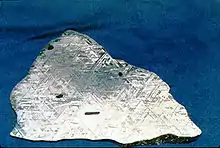William Thomson (mineralogist)
William Thomson (1760 – November 1806) was an English mineralogist, who used the name Guglielmo Thomson in Italy in later life. He died in Palermo at the age of 46 years.[1][2]
Guglielmo Thomson | |
|---|---|
| Born | William Thomson 1760 |
| Died | 1806 (aged 46) |
| Nationality | English |
| Occupation | Geologist |
| Known for | Discovery of Widmanstätten pattern |
Discovery of Widmanstätten pattern

Thomson at the time was living in Naples. One day he decided to treat a sample of the Krasnojarsk meteorite with nitric acid for the purpose of cleaning it of rust. Shortly after the contact with acid he noticed on the surface of the metal a strange never seen before figures: it was the later-called Widmanstätten pattern.
In 1804, his discovery was published in the Bibliothèque Britannique, in French.[3][1][4]:125[5] After his death, his work was published in 1808 in Italian (translated from the original English manuscript) on Atti dell'Accademia Delle Scienze di Siena.[6][7][8]
The discovery is commonly referred to as the Widmanstätten pattern after a similar discovery in 1808 by Count Alois von Beckh Widmanstätten, the director of the Imperial Porcelain works in Vienna, while flame heating iron meteorites,[9] probably due the early death of Thomson and the lack of an English publication. The discovery of Widmanstätten was independent, but he did not publish his findings after he noticed color and luster zone differentiation as the various iron alloys oxidized at different rates. His findings were merely orally communication with his colleagues. The discovery was acknowledged by Carl von Schreibers, director of the Vienna Mineral and Zoology Cabinet, who named the structure after Widmanstätten.[10][11]:124
Due to chronological priority, the full credit of the discovery should be assigned to Thomson. For this reason, several authors have suggested that the pattern also be called the Thomson structure.[1][4][12]
See also
References
- Gian Battista Vai, W. Glen E. Caldwell. The origins of geology in Italy. Geological Society of America, 2006, ISBN 0-8137-2411-2. – p.184
- Torrens, H. S. "Thomson, William". Oxford Dictionary of National Biography (online ed.). Oxford University Press. doi:10.1093/ref:odnb/64672. (Subscription or UK public library membership required.)
- Thomson, G. (1804) "Essai sur le fer malléable trouvé en Sibérie par le Prof. Pallas" (Essay on malleable iron found in Siberia by Prof. Pallas), Bibliotèque Britannique, 27 : 135–154 ; 209–229. (in French)
- John G. Burke. Cosmic Debris: Meteorites in History. University of California Press, 1986. ISBN 0-520-05651-5
- F. A. Paneth. The discovery and earliest reproductions of the Widmanstatten figures. Geochimica et Cosmochimica Acta, 1960, 18, pp.176–182
- Thomson, G. (1808). "Saggio di G.Thomson sul ferro malleabile trovato da Pallas in Siberia" [Essay by G. Thomson on malleable iron found by Pallas in Siberia]. Atti dell'Accademia delle Scienze di Siena (in Italian). 9: 37–57.
- Golia, M (2015) Meteorite: Nature and Culture, London: Reaktion Books Limited
- Bettoni, G, Faccioli, M and Salvatori, F (2013) documention geography: n. 1 febbraio - luglio - nuova serie, Rome: Edizioni Nuova Cultura
- O. Richard Norton. Rocks from Space: Meteorites and Meteorite Hunters. Mountain Press Pub. (1998) ISBN 0-87842-373-7
- Schreibers, Carl von (1820). Beyträge zur Geschichte und Kenntniß meteorischer Stein und Metalmassen, und Erscheinungen, welche deren Niederfall zu begleiten pflegen [Contributions to the history and knowledge of meteoric stones and metallic masses, and phenomena which usually accompany their fall] (in German). Vienna, Austria: J.G. Heubner. pp. 70–72.
- John G. Burke. Cosmic Debris: Meteorites in History. University of California Press, 1986. ISBN 0-520-05651-5
- O. Richard Norton. The Cambridge encyclopedia of meteorites. Cambridge, Cambridge University Press, 2002. ISBN 0-521-62143-7.